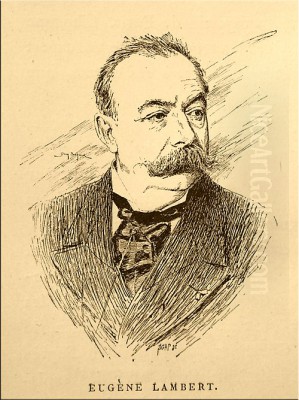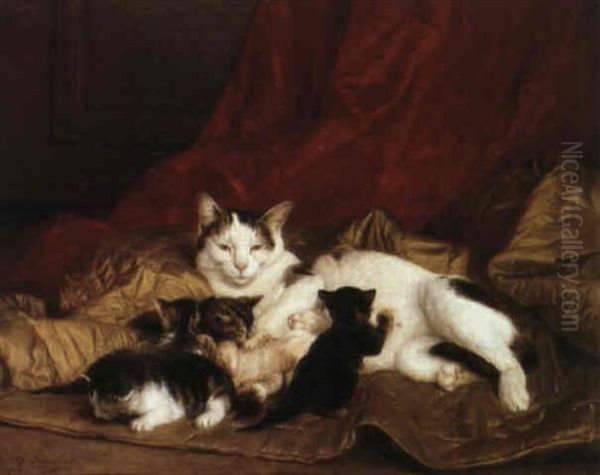
Louis Eugène Lambert stands as a notable figure in nineteenth-century French art, primarily celebrated for his charming and skillfully executed paintings of animals, particularly cats and dogs. Born in France in 1825, Lambert carved a distinct niche for himself within the bustling Parisian art world, eventually earning the affectionate moniker "Raphael of Cats" for his elegant portrayals of feline subjects. His career spanned a significant period of artistic change, yet he remained dedicated to a style characterized by careful observation and technical refinement, achieving considerable success and recognition during his lifetime.
Early Life and Artistic Formation
Details surrounding Louis Eugène Lambert's earliest years remain somewhat scarce in common records, but his artistic journey began under the tutelage of two highly influential figures in French art: Eugène Delacroix and Paul Delaroche. This training provided him with a formidable foundation, exposing him to contrasting yet complementary artistic philosophies. Delacroix, the towering figure of French Romanticism, would have imparted lessons in expressive color, dynamic composition, and the emotional potential of painting. His influence might be subtly detected in the vitality Lambert often captured in his animal subjects.
Conversely, Paul Delaroche was a master of the academic style, renowned for his historical paintings characterized by meticulous detail, smooth finish, and dramatic, almost theatrical, staging. Training with Delaroche would have instilled in Lambert a strong emphasis on draughtsmanship, anatomical accuracy, and the polished execution valued by the official art institutions of the time, particularly the Paris Salon. This dual influence likely shaped Lambert's ability to combine lively representation with technical precision. He entered the art world during a period dominated by figures like Jean-Auguste-Dominique Ingres, the champion of Neoclassicism, and Gustave Courbet, who was challenging traditions with his bold Realism.
Debut and Rise to Prominence

Lambert made his official debut on the Parisian art scene by exhibiting at the prestigious Paris Salon in 1847. The Salon was the paramount venue for artists seeking recognition and patronage in nineteenth-century France. Acceptance and success at the Salon could launch a career, and Lambert began steadily building his reputation through regular participation. While his initial works included still lifes and bird paintings, his true breakthrough came later.
A pivotal moment occurred in 1857 when Lambert exhibited his painting Cats and Parrots at the Salon. This work garnered significant attention and critical acclaim, effectively establishing him as a leading painter of domestic animals, especially cats. The subject matter resonated with the public and critics alike, tapping into a growing appreciation for genre scenes and animal portraiture. This success marked a turning point, solidifying his focus on the subjects that would define his career and lead to widespread popularity.
The rise of specialized animal painters, known as animaliers, was a distinct feature of the nineteenth-century art market. Artists like Rosa Bonheur, celebrated for her powerful depictions of horses and farm animals, and Antoine-Louis Barye, famed for his dramatic bronze sculptures of animals in combat, had already elevated the status of animal art. Lambert joined their ranks, though his focus was often more intimate and domestic, concentrating on the charm and personality of household pets.
The Master of Feline Portraits
Following the success of Cats and Parrots, Louis Eugène Lambert became increasingly renowned for his depictions of cats. He developed an extraordinary ability to capture not just their physical likeness but also their characteristic behaviours – their playful antics, moments of quiet repose, maternal instincts, and innate elegance. His paintings often feature kittens interacting with their mothers, cats curiously exploring domestic settings, or simply posing with a dignified air. This focus earned him the nickname "Raphael of Cats," suggesting a comparison to the High Renaissance master's grace and compositional harmony, applied to the feline form.
His style was marked by fine brushwork, careful attention to the texture of fur, and a sensitive use of light and shadow to model forms and create atmosphere. He avoided overt sentimentality, instead imbuing his subjects with a sense of naturalism and individual character. While cats were his most famous subjects, he also painted dogs and other animals with considerable skill.
Among his representative works, beyond the pivotal Cats and Parrots, are paintings like Famille de chats (Family of Cats), which exemplifies his tender and observant approach to feline family life. Another noted work, Bassecour (often translated as Chicken Yard or Poultry Yard), held in the collection of the Musée d'Arts de Nantes, demonstrates his skill extended to other animal subjects and settings, showcasing his abilities within the broader genre of animal painting. His work can be seen in relation to other European artists specializing in similar themes, such as the Dutch-Belgian painter Henriëtte Ronner-Knip, who also gained fame for her charming cat paintings later in the century. Lambert's focus on domestic animals also echoes, in a different context, the intimate domesticity found in the still lifes and genre scenes of an earlier French master, Jean-Baptiste-Siméon Chardin.
Official Recognition and Later Career
Lambert's dedication and skill did not go unnoticed by the French art establishment. His consistent presence at the Salon was rewarded with official accolades. He received medals in 1865, 1866, and again in 1870, signifying the high regard in which his work was held by the Salon juries. These awards cemented his status as a successful and respected artist within the mainstream art world of the Second Empire and early Third Republic.
A further significant honour was bestowed upon him in 1874 when he was made a Chevalier of the Legion of Honour (Légion d'honneur). This prestigious award recognized his contributions to French art and culture, placing him among the ranks of the nation's officially celebrated talents. Such recognition was highly sought after and marked a pinnacle of success for artists operating within the academic system, akin to honours received by contemporaries like the highly polished academic painters William-Adolphe Bouguereau or Jean-Léon Gérôme.
Lambert continued to exhibit his work, participating in major international events such as the Exposition Universelle (World's Fair) held in Paris in 1878. These large-scale exhibitions provided artists with a global platform to showcase their talents. Beyond his easel paintings, Lambert also engaged in illustration work, notably creating drawings for fables, including potentially those of the famous French writer Jean de La Fontaine, as well as for works by Charles de Trianon. This diversification further demonstrated his artistic versatility.
Artistic Style and Context
Louis Eugène Lambert's artistic style remained largely consistent throughout his career, rooted in the principles of realism and careful execution learned from his teachers. The influence of Delaroche is evident in the meticulous rendering of detail, particularly in the textures of fur and feathers, and the overall polished finish of his canvases. While perhaps less overt, the legacy of Delacroix might be seen in the lifelike energy and subtle psychological presence he captured in his animal subjects, preventing them from becoming mere static representations.
He operated during a time of radical artistic innovation in France, most notably the rise of Impressionism in the 1860s and 1870s. While artists like Claude Monet, Pierre-Auguste Renoir, and Edgar Degas were revolutionizing painting with their focus on light, colour, and fleeting moments of modern life, Lambert adhered to a more traditional approach. He did not embrace the loose brushwork or avant-garde compositional strategies of the Impressionists. Instead, his work remained firmly within the lineage of French realism, specializing in a popular and accessible genre.
His chosen subject matter, animal painting, allowed him to achieve popular success while maintaining high standards of technical skill. He provided charming, beautifully crafted images that appealed to the tastes of the bourgeoisie and collectors who appreciated both artistry and relatable themes. His dedication to this niche set him apart from painters tackling grand historical narratives or the radical experiments of the avant-garde.
Legacy and Collections
Louis Eugène Lambert passed away in 1900, leaving behind a significant body of work dedicated primarily to the depiction of animals. His legacy is that of a highly skilled and successful specialist painter who achieved considerable fame during his lifetime for his mastery in portraying cats and dogs. He remains best known as the "Raphael of Cats," a title that encapsulates the elegance and technical proficiency that characterized his work.
His paintings found their way into numerous private and public collections. Notably, examples of his work are held by major institutions such as the British Museum in London and were acquired by the French state for the Musée du Luxembourg in Paris (works from this collection are now typically housed in the Musée d'Orsay). The presence of his art in these prestigious collections underscores the recognition he received during his era.
Despite his contemporary success and the enduring appeal of his subject matter, academic art history has perhaps paid less focused attention to Lambert compared to the revolutionary figures of his time, such as the Impressionists or Post-Impressionists like Paul Cézanne or Vincent van Gogh. However, within the specific field of animal painting, he holds a secure and respected place. His work continues to be appreciated by collectors and the public for its charm, sensitivity, and masterful execution.
Context and Contemporaries
While Lambert studied under Delacroix and Delaroche, specific records detailing his interactions with other prominent artists of his time are limited. The nineteenth-century Parisian art world was a vibrant milieu, and artists frequently crossed paths at studios, cafés, Salons, and galleries. It is highly likely Lambert knew many of the leading figures, but documented friendships or collaborations beyond his teachers are not widely cited.
His career unfolded alongside major figures across the artistic spectrum. In addition to the aforementioned Ingres, Courbet, Bonheur, Barye, Monet, Renoir, and Degas, his contemporaries included Édouard Manet, whose work bridged Realism and Impressionism; Camille Pissarro and Berthe Morisot, key figures in the Impressionist circle; Ernest Meissonier, renowned for his incredibly detailed historical and military scenes; and Honoré Daumier, the powerful caricaturist and painter of social commentary. Lambert's artistic path, focused on animal painting within a broadly realist and academic framework, offered a distinct contrast to the diverse artistic currents swirling around him.
It is important to distinguish the painter Louis Eugène Lambert from the fictional character of the same name in Honoré de Balzac's novel Louis Lambert (1832). The painter has no connection to this literary creation. Furthermore, historical records mention other individuals named Lambert during this period, such as the inventor Frank Lambert or the mathematician Jean-Heinrich Lambert, none of whom are related to the artist. Anecdotes specifically about the painter Louis Eugène Lambert's personal life are not well-documented, leaving his artwork as the primary testament to his life and career.
Conclusion
Louis Eugène Lambert occupies a unique and endearing position in the history of nineteenth-century French art. As a student of both Delacroix and Delaroche, he synthesized elements of Romantic vitality and Academic precision to become the preeminent painter of cats of his generation. His success at the Paris Salon, culminating in medals and the Legion of Honour, attests to his skill and the appeal of his chosen specialty.
While perhaps overshadowed in broad art historical narratives by the groundbreaking movements of his time, Lambert's dedication to animal painting, particularly his sensitive and graceful depictions of felines, earned him lasting recognition and the affectionate title "Raphael of Cats." His works, found in museums and private collections, continue to charm viewers with their technical mastery and intimate portrayal of the animal world, securing his legacy as a significant and beloved animalier of the French school.